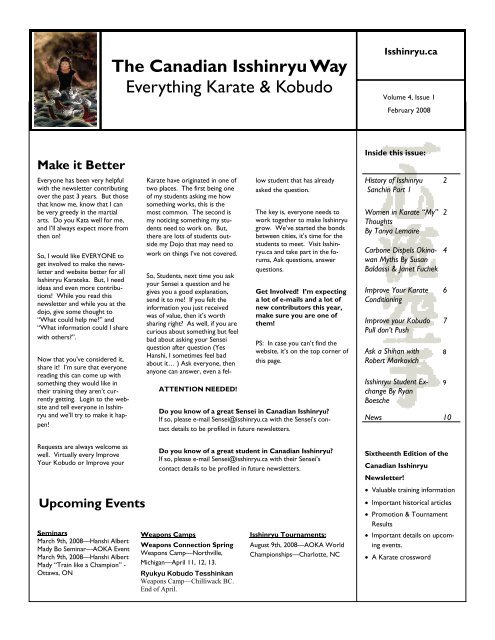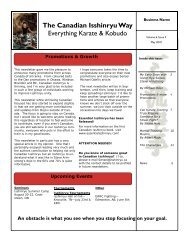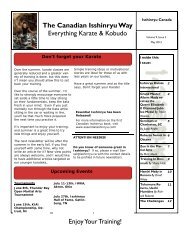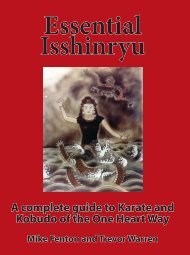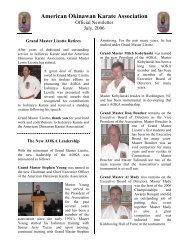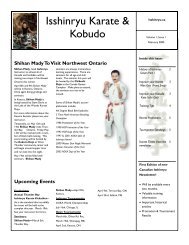The Canadian Isshinryu Way Everything Karate ... - Isshinryu.ca
The Canadian Isshinryu Way Everything Karate ... - Isshinryu.ca
The Canadian Isshinryu Way Everything Karate ... - Isshinryu.ca
Create successful ePaper yourself
Turn your PDF publications into a flip-book with our unique Google optimized e-Paper software.
<strong>The</strong> <strong>Canadian</strong> <strong>Isshinryu</strong> <strong>Way</strong><strong>Everything</strong> <strong>Karate</strong> & Kobudo<strong>Isshinryu</strong>.<strong>ca</strong>Volume 4, Issue 1February 2008Make it BetterEveryone has been very helpfulwith the newsletter contributingover the past 3 years. But thosethat know me, know that I <strong>ca</strong>nbe very greedy in the martialarts. Do you Kata well for me,and I’ll always expect more fromthen on!So, I would like EVERYONE toget involved to make the newsletterand website better for all<strong>Isshinryu</strong> <strong>Karate</strong>ka. But, I needideas and even more contributions!While you read thisnewsletter and while you at thedojo, give some thought to“What could help me?” and“What information could I sharewith others?”.Now that you've considered it,share it! I’m sure that everyonereading this <strong>ca</strong>n come up withsomething they would like intheir training they aren’t currentlygetting. Login to the websiteand tell everyone in <strong>Isshinryu</strong>and we’ll try to make it happen!<strong>Karate</strong> have originated in one oftwo places. <strong>The</strong> first being oneof my students asking me howsomething works, this is themost common. <strong>The</strong> second ismy noticing something my studentsneed to work on. But,there are lots of students outsidemy Dojo that may need towork on things I’ve not covered.So, Students, next time you askyour Sensei a question and hegives you a good explanation,send it to me! If you felt theinformation you just receivedwas of value, then it’s worthsharing right? As well, if you arecurious about something but feelbad about asking your Senseiquestion after question (YesHanshi, I sometimes feel badabout it… ) Ask everyone, thenanyone <strong>ca</strong>n answer, even a fel-ATTENTION NEEDED!low student that has alreadyasked the question.<strong>The</strong> key is, everyone needs towork together to make <strong>Isshinryu</strong>grow. We’ve started the bondsbetween cities, it’s time for thestudents to meet. Visit <strong>Isshinryu</strong>.<strong>ca</strong>and take part in the forums,Ask questions, answerquestions.Get Involved! I’m expectinga lot of e-mails and a lot ofnew contributors this year,make sure you are one ofthem!PS: In <strong>ca</strong>se you <strong>ca</strong>n’t find thewebsite, it’s on the top corner ofthis page.Do you know of a great Sensei in <strong>Canadian</strong> <strong>Isshinryu</strong>?If so, please e-mail Sensei@isshinryu.<strong>ca</strong> with the Sensei’s contactdetails to be profiled in future newsletters.Inside this issue:History of <strong>Isshinryu</strong>Sanchin Part 1Women in <strong>Karate</strong> “My”ThoughtsBy Tanya LemaireCarbone Dispels OkinawanMyths By SusanBaldassi & Janet FuchekImprove Your <strong>Karate</strong>ConditioningImprove your KobudoPull don’t PushAsk a Shihan withRobert Markovich<strong>Isshinryu</strong> Student ExchangeBy RyanBoescheNews 102246789Requests are always welcome aswell. Virtually every ImproveYour Kobudo or Improve yourUpcoming EventsSeminarsMarch 9th, 2008—Hanshi AlbertMady Bo Seminar—AOKA EventMarch 9th, 2008—Hanshi AlbertMady “Train like a Champion” -Ottawa, ONDo you know of a great student in <strong>Canadian</strong> <strong>Isshinryu</strong>?If so, please e-mail Sensei@isshinryu.<strong>ca</strong> with their Sensei’scontact details to be profiled in future newsletters.Weapons CampsWeapons Connection SpringWeapons Camp—Northville,Michigan—April 11, 12, 13.Ryukyu Kobudo TesshinkanWeapons Camp—Chilliwack BC.End of April.<strong>Isshinryu</strong> Tournaments:August 9th, 2008—AOKA WorldChampionships—Charlotte, NCSixtheenth Edition of the<strong>Canadian</strong> <strong>Isshinryu</strong>Newsletter!• Valuable training information• Important histori<strong>ca</strong>l articles• Promotion & TournamentResults• Important details on upcomingevents.• A <strong>Karate</strong> crossword
Page 2<strong>The</strong> <strong>Canadian</strong> <strong>Isshinryu</strong> <strong>Way</strong>Sanchin—Part 1By Mike FentonUnderstanding the history of the <strong>Isshinryu</strong> kata <strong>ca</strong>nprovide the <strong>Isshinryu</strong> <strong>Karate</strong>ka with a greaterknowledge of the kata and the techniques it employs.<strong>The</strong> origins of a kata <strong>ca</strong>n guide us towardunderstanding both the appli<strong>ca</strong>tion of the techniqueas a student and a deeper respect for the evolutionof the art as an instructor.<strong>The</strong> information within this article is a result ofresearch done as part of a book in progress. It is torepresent a comprehensive resource of data concerningthe art for all <strong>Karate</strong>ka. While every efforthas been taken to ensure accuracy of the information,any corrections or additional details are welcomefrom one and all.<strong>The</strong> Myth’sThis is perhaps the most serious myth associatedwith any of the kata. That is that Sanchin is bad foryour health. It was reported for a number of yearsthat on Okinawa the masters who trained Sanchinwere damaging their internal organs with all theincreased pressure and as a result died younger thanmost on Okinawa.While a large enough study has not been done, andprobably never will be done. This belief arose froma very small number, and a number which <strong>ca</strong>n beequally balanced with other well known martialartists who regularly practiced Sanchin and lived along life.“Sanchin translatesas “Three Battles” “<strong>The</strong> NameSanchin Kata<strong>The</strong> kanji for Sanchin is fairly easy to interpret andwritten very similar by almost all histori<strong>ca</strong>l texts.Sanchin translates as “Three Battles” or “ThreeConflicts” both are acceptable translations and generallyindi<strong>ca</strong>te the same meaning. Analysis of thetranslation shows the true meaning of the kata.I sincerely hope that you enjoyed reading this. <strong>The</strong>next article will continue the background of Sunsuwith the bulk of the article primarily on the kata’sorigins focusing specifi<strong>ca</strong>lly on the path the kata tookon it’s way to Shimabuku Tatsuo and it’s incorporationinto <strong>Isshinryu</strong> Kata. If you have corrections orcomments regarding this article or any future article,please feel free to contact me directly.I sincerely hope that you enjoyed reading this. <strong>The</strong>next article will begin the background of Sunsu andits unique place in <strong>Isshinryu</strong>. If you have correctionsor comments regarding this article or any futurearticle, please feel free to contact me directly.<strong>The</strong> three battles are usually referred to as mind,breath and spirit, although other interpretations arepossible. Through the mastery of these three elementsof a conflict, a karate-ka becomes truly unstoppable.Its fun to people watch, isn’t it? How a person approachesnew situations and how they handle themselvesreally tells you a lot about them. As a waterbottle, I do a lot of sitting on the sidelines andwatching people as they participate in their chosenactivities.I have had the pleasure of watching someone takeup various sports over their lifetime such as horsebackriding, downhill skiing, Ultimate Frisbee, runningand karate. Of all her activities I <strong>ca</strong>n safely saythat karate has changed her the most, for the better.Mike Fentonmike@isshinryu.<strong>ca</strong>Women in <strong>Karate</strong> “My” ThoughtsBy Tanya LemaireAs her water bottle, I watched with pride and pleasureover the last nine years as she worked on hertechnique with basics and kata, gained confidence inherself for sparring and self defense and learnedwhat made her tick as a karate-ka and a person. Shehas overcome personal challenges and takes her rolein the dojo as Sempai, and that of the only female inthe karate club, very seriously. She has learned tooffer sound and experienced advice and guidance tofellow club members, which from what I <strong>ca</strong>n tell, iswell received.<strong>The</strong>se days we’re preparing for Shodan testing. And(Continued on page 3)
Volume 4, Issue 1Page 3Women in <strong>Karate</strong> “My” Thoughts Cont’dBy Tanya Lemaire(Continued from page 2)wow, what a ride this has been! She has taken everythingshe’s learned about karate in the last nine yearsand about herself as a person, and is focusing her attentionand energy into preparing for this event. I’ve neverseen her as busy as she works out almost every day toprepare her mind and body for this new challenge. Shetook up boxing to improve and control her power tohelp with her sparring. She started running again tomeet the Shodan physi<strong>ca</strong>l requirement and to increaseher <strong>ca</strong>rdio fitness. As her proud water bottle, I <strong>ca</strong>n saywe’re on the go and having fun!I should take this moment to point out that she wasdiagnosed with asthma six years ago and that’s it’s veryhard for me to watch her struggle whenever she hasflare ups. But it is encouraging to see her learn to usethese challenging moments to deepen her resolve toovercome this disease in order to continue to improveher fitness and endurance and, to continue her karate<strong>ca</strong>reer. She uses her weaknesses as challenges to overcomeand faces them head on to the best of her ability.This trait has been strengthened by her commitment tokarate and is one she shares with the club’s junior kyuto encourage them and help them along with their personalchallenges with karate.As I’ve mentioned before, I’m a water bottle, so speakingabout the inner thoughts and feelings of humans is not myspecialty. But what I <strong>ca</strong>n do, and I do it a lot, is observepeople and make comments on what I see of their behavior.What I see are people who enjoy the challenges ofmartial arts, whether they are male or female, and that toprogress in this sport is to find your own path. I haveseen my owner struggle to bring the “Eye of the Tiger”,i.e. more power, to her kata and to overcome some personalstruggles to become a better fighter in class. Butwhat I also observe are the men finding their own path inkarate as well. So to me, the differences are not in whathas to be overcome, but in how the challenges are met.Women in karate, and I’ve seen this time and again, havemany additional demands on their time such as raisingchildren and taking <strong>ca</strong>re of their homes, whereas the menseem to be less burdened with these demands. Over thenine years she has been studying karate we have seenmany women come and go, the men too, but the ratio ismuch higher for women. This is too bad since karate is anactivity with so many more benefits than just the sweat.Oh well, there’s not much I <strong>ca</strong>n do from the sidelines butto provide the hydration and all she <strong>ca</strong>n do is be there forthe women when they do come to try the classes out andencourage them as best she <strong>ca</strong>n.“Women in karate,and I’ve seen thistime and again, havemany additionaldemands on theirtime such as raisingchildren and taking<strong>ca</strong>re of their homes,whereas the menseem to be lessburdened with thesedemands. “From what I <strong>ca</strong>n see, her challenges are the same asthose the men in the club have to overcome. It seems asthough everyone at one point struggles with lack of selfconfidence, fear of failure and even the physi<strong>ca</strong>l part ofkarate. From what I <strong>ca</strong>n see, as a mere water bottle, nottoo many people <strong>ca</strong>n do fifty knuckle push ups right offthe bat, this skill takes training and commitment. Usingher learned experience, she has offered support andguidance to those who seek if and has grown into herrole as Sempai.Compared to the other sports I’ve seen her do, horsebackriding, Ultimate Frisbee and volleyball, karate,unlike other individual sports, really becomes a way oflife where the person embraces the true meaning of“empty hands” in their day to day life by growing as aperson as their skills develop. I’ve seen her confidencein her abilities grow over the years and it’s quite thething to say that you’re doing karate and that you sparwith people and break boards, for fun! She gets a lot ofraised eyebrows when she tells people she’s a BrownBelt in karate and that yes she fights against boys. Whatthey don’t understand, since they don’t understand thetrue meaning of karate and how it changes a person, isthat she chooses to do this activity year after year andchooses to overcome her internal fears to become astronger and more grounded person. Simply choosing tocome back time after time is noteworthy. Gotta respectthat eh?From my perspective on the sidelines, the most obviouschallenge that women face, more so than the men, is thephysi<strong>ca</strong>l component of karate. In this club there is noquarter given to the women when it comes to the physi<strong>ca</strong>lrequirements such as push ups, crunches, running andsparring. It is understood that these things are harder, butthe expectation is still the same. In some ways it’s encouragingfor her, and other women, to be treated the same,but on the other hand it is also difficult knowing thatyou’re entering the same arena, so to speak, with a signifi<strong>ca</strong>ntdisadvantage.I know for her, it has helped tremendously knowing herSenseis understand that the physi<strong>ca</strong>l differences are difficultand they are encouraging and supporting her trainingalong the way. See this is where having other women inthe club is good so they <strong>ca</strong>n share their frustrations withsomeone who has or is in the same situation. This is thedifference between empathy from other women andsympathy from the men. Big words for a water bottle eh?So there are “my” thoughts on women in karate, havinghad the distinct advantage of observing a woman in trainingfrom their white belt through to final preparations fortheir black belt. It has been quite the ride with many upsand downs and I <strong>ca</strong>n only look forward to her next chapter,or first step, in karate as a Shodan! She is so going tokick some butt!
Page 4<strong>The</strong> <strong>Canadian</strong> <strong>Isshinryu</strong> <strong>Way</strong>Carbone Dispels Okinawan MythsBy Susan Baldassi and Janet Fuchek“During the seminars,he imparted not onlyseveral valuableweapons techniques,including those of theGusan (Okinawan jo),tanbo (short stick),bo, sai and tonfa, butalso his martial-artsrelated knowledge ofOkinawa, which hevisited 26 times todate to further histraining with some ofthe best on theisland..“If you’ve heard any myths about <strong>Isshinryu</strong> karateand weaponry, ninth-degree-black belt Peter Carbonewill set you straight.<strong>The</strong> high-ranking master in Ryukyu Kobujutsu, whois also an eighth-degree-black belt in <strong>Isshinryu</strong> <strong>Karate</strong>and Kobudo, did just that in a series of traditionalRyukyu Kobudo (weaponry) workshops heconducted Jan. 18-20 in Thunder Bay, Ontario. <strong>The</strong>61-year-old-icon, who hails from Northville in theDetroit, Michigan, area, is also President of theRyukynote Kobujutsu Hozon Budo Kyokai inAmeri<strong>ca</strong>.“I want to share my edu<strong>ca</strong>tion with everyoneelse,” says the passionate martial artist, who wasimpressed with the participants’ determination andhopes to return to put on other seminars. “It appearsto me that everybody is sincere and hungryfor more knowledge.”Carbone braved the shocking cold of NorthernCanada to venture to this small city, nestled onthe shores of Lake Superior and less than an hour’sdrive from the Minnesota border. Besides hockey,martial arts is quite popular there. Some peopleeven consider the Lakehead - its other commonname - to be “the martial arts <strong>ca</strong>pital of Canada”due to the city’s unique Thunder Bay Martial ArtsCouncil. This innovative organization defies thefallacy that various arts and styles don’t mix, asmembers representing different clubs work togetherto promote the martial arts lo<strong>ca</strong>lly.Close to 50 martial artists, from children to adults,attended the weekend affair - some as far away asDryden and Sioux Lookout, which are about athree-and-a-half and five hours’ drive, respectively,from Thunder Bay. <strong>The</strong>y gathered to see a weaponrylink to Okinawan Grand Masters NakamotoKiichi and Uezu Angi, son-in-law to Grand MasterShimabuku Tatsuo. Carbone, who considers himselfto be Uezu’s first student, qualifies as the weaponspowerhouse who fulfills this role. During the seminars,he imparted not only several valuable weaponstechniques, including those of the Gusan (Okinawanjo), tanbo (short stick), bo, sai and tonfa, but also hismartial-arts related knowledge of Okinawa, which hevisited 26 times to date to further his training withsome of the best on the island.One myth that he hopes to dispel is that the sai is anancient Okinawan farming tool. According to Carbone’sresearch, however, it was designed to bestrictly a weapon.Another is that Grand Master Shimabuku Tatsuostudied Gojuryu <strong>Karate</strong> extensively. False, figures themartial artist, adding that he heard he studied the artto a lesser extent, offering to pay for lessons to financiallyhelp the instructor Miyagi Chojun – who wasalso a school teacher – after devastations he sufferedduring war.With his vast wisdom, Carbone was a hit with bothparticipants and spectators, alike.“He was really nice – a good teacher,” concur eightyear-oldtwins Megan and Rachel Rubin, agreeing thatthey value above all the bo basics he showed them.Fans at the sidelines, like the girls’ father Dave, absorbedCarbone’s teachings through observation.“I liked the way he spoke to people,” says theformer martial artist of the guest instructor. “He wasto the point and informative. You could understand it.
Volume 4, Issue 1Page 7Improve your <strong>Karate</strong>Conditioning Cont’dat the wrist and work up to the elbow and then back.Starting a single trip up and down should be sufficient.Just like striking, as you get stronger and more comfortable,build up the intensity of the strike as well asthe number of strikes you do going up and down.You’ll also begin to learn which part of your arm isstronger and weaker so that you <strong>ca</strong>n strike harder atcertain points.Other areas that <strong>ca</strong>n be conditioned like this are theupper arm, inner forearm, inner and outer thigh. Inaddition to the muscles, you <strong>ca</strong>n also condition thebones on the top and bottom of the forearm.Don’t forget that healing is the most important partof conditioning. Immediately after conditioning, rubthe surface you were conditioning to stimulate bloodflow to the area. Your blood <strong>ca</strong>rries everything yourbody needs to heal and strengthen the area so thesooner the blood gets to it the sooner it will heal.Always wait for it to heal before repeating the conditioning!If it is still sore, it means it hasn’t healed andyou risk injuring yourself (and setting back your conditioningprogress).Final Tip: <strong>The</strong> progress may seem slow, but thisis very much a <strong>ca</strong>se of slow and steady wins therace. Keep it up and you’ll rarely feel pain whenblocking or striking. A VERY useful trait tohave.In the next newsletter I’ll discuss <strong>ca</strong>rdiovascular conditioning.Improve your KobudoPull don’t Push<strong>The</strong> Bo is a challenging weapon to use be<strong>ca</strong>use youmust coordinate movement with both sides of thebody. This is not a common requirement for martialartist as they typi<strong>ca</strong>lly use each arm in unison performingtheir movements freely. With the bo whenone hand moves the other must follow.Keeping that in mind, one hand needs to be the“guide” hand, directing the action, while the otherhand is the engine, powering the movement. Notice, Idon’t say front or back hand? That is be<strong>ca</strong>use thehand position will vary depending on the strike.the engine to drive it as quickly as possible. After onlya few attempts you should be able to generate signifi<strong>ca</strong>ntpower in the strike (and make a nice whooshingsound as well).Once you’ve got the basic strike down, you must addon the hip motion. Moving your hips properly not onlyincreases the power of the movement, but positionsyour body to optimally provide a stable anchor behindthe strike to eliminate absorption of the force awayfrom the strike.“one hand needs tobe the “guide” hand,directing the action,while the other hand isthe engine, poweringthe movement”.Let’s focus on the side strike, it’s a simple motionwith the bo travelling across the body striking to thetemple. And, it <strong>ca</strong>n be done back and forth for easytraining. All “swinging” bo strikes, should be drivenby the pull, the engine is pulling the bo back towardsyour body (a strong movement) at the same time thehips twist to strengthen the movement while the“guide” hand maintains the angle ensuring the strike ison target.Now that I’ve described it, here’s how you <strong>ca</strong>n practiceit.Start in your proper oblique Seisan stance holdingyour bo in a ready position.Quickly pull your front hand directly down to yourfront hip while directing the other end of the bo tothe temple. <strong>The</strong> middle of the bo should “roll”across your body. Relax the “guide” hand and allowDoing the same movement as the previous strike, addin the hip motion, Any hip motion must be timed preciselywith the hand / bo motion. <strong>The</strong> hips should twistin the direction the strike is travelling.<strong>The</strong> optimal end position for the strike is with the boperpendicular to the other thigh, using it as brace forthe strike. Both drills should be done repeatedly inboth directions. I recommend starting with just thehands in a single direction and adding it step by step.Once you have the motion done, it’s time to extendthe motion to all strikes, pull your strikes powerfullyand any swinging strike will powerful and more natural.Many incorrect bo movements are <strong>ca</strong>used by peopletrying to push the bo around. Just remember PullDon’t Push!
Page 8<strong>The</strong> <strong>Canadian</strong> <strong>Isshinryu</strong> <strong>Way</strong>Ask a ShihanBiography of Robert Markovich“I think that after 40years it has become away of life, not tomention that it is away to remain healthyand active. If I stopdoing it I'll feel guiltyand there will besomething missing“Shihan Markovich was born 30 August 1940 inYugoslavia and moved to Windsor, Ontario Canadaat age 10. He began his <strong>Isshinryu</strong> training in 1969under Lloyd Russette, Don Shapland and DougNoxon. Shihan Markovich received his Shodan in1971 and his Hachidan in July of 2002. In additionto his <strong>Isshinryu</strong> training Shihan Markovich also continuedlearning and in 2007 earned his 2nd DegreeBlack Belt in Modern ArnisShihan Markovich has been a member of the Ameri<strong>ca</strong>nOkinawan <strong>Karate</strong> Association (AOKA) since1971 currently serving on the promotion board. Hehas instructed in a number of dojos in the WindsorCanada area. His students include Albert Mady andLamont Kersey. Shihan Markovich was also a memberof the <strong>Canadian</strong> <strong>Isshinryu</strong> <strong>Karate</strong> Association(CIKA) from 1988 until its disestablishment in 1993.His awards include, the Hall of Fame award for outstandingcontributions to <strong>Isshinryu</strong> <strong>Karate</strong> in 1999and the AOKA Spirit of <strong>Isshinryu</strong> award in 2002.Master Markovich is also a former member of the<strong>Canadian</strong> Armed forces and Reserves who receivedhis commission as a full lieutenant in 1965. Hegraduated with a BA in Geography from the Universityof Windsor and after attending Teacher's College,began his secondary school teaching <strong>ca</strong>reer in1969. He completed his Master Degree in Geographyin 1971 and a second Masters Degree in FineArt in 1987. Master Markovich retired from secondaryschool teaching in 1997, and keeps busy via avariety of activities, including artwork, picture framingand martial arts training.Ask a ShihanAnswers By Robert MarkovichQ1. You have been training in <strong>Isshinryu</strong> for along time but continue to branch out trainingin Arnis and opening new Dojo’s. Whatpushes you to keep improving and helpingothers improve?A1. Well, as I said before, my wife thinks that I'mcrazy. However, I don't agree with this point ofview. I think that after 40 years it has become a wayof life, not to mention that it is a way to remainhealthy and active. If I stop doing it I'll feel guilty andthere will be something missing. Another importantfactor for me are the friendships of like-mindedpeople that I have developed over the years. My<strong>ca</strong>reer has been teaching. I was a high schoolteacher until I retired and I enjoyed it. <strong>Karate</strong> is anextension of this.
Volume 4, Issue 1Page 9Ask a ShihanAnswers By Robert Markovich Cont’dQ2. What Kata do you most enjoy teaching?A2. I enjoy teaching Seisan kata the most be<strong>ca</strong>usethere is so much in it in terms of appli<strong>ca</strong>tions. <strong>The</strong>'chicken head' block <strong>ca</strong>n be translated into five or sixeffective techniques, just to mention one move. <strong>The</strong>kata that I like to perform however is Chinto.When one becomes older one finds that it becomesmore difficult to keep up. That is why it is good tolearn grappling techniques so that it becomes possibleto subdue an opponent quickly. <strong>The</strong>re are a lot ofgrappling techniques in kata.Q5. What are you most proud of as an Instructor?Q3. What is your favorite memory from yourtime as a student?A3. I think my favorite memory is being young andtraining at a time when karate was a fairly new sportfor North Ameri<strong>ca</strong>ns and no one had to worry aboutbeing taken to court.Q4. What do you wish <strong>Isshinryu</strong> <strong>Karate</strong>ka ingeneral would put more effort into?A5. I guess that I am most proud of the fact that atnearly 68 I am still in the game and able to work withmy students at almost the same physi<strong>ca</strong>l level as I'vealways done. I am also pleased that I have not becomestale mentally. Each new group of students is a newchallenge. It is very gratifying to see them succeed andprogress through the ranks.Q6. At this point in your training, who wouldyou most like the opportunity to train with andlearn from (any style, anywhere)?A4. I think that everyone should put a lot more effortinto basics as they are the foundation of good kataand good self defense. Kumite is good but it <strong>ca</strong>n takeyou only so far. Kumite is a sport for the young.For those of you who don’t know us, the Kokoro Dojoin Berlin, Germany is a sister dojo to the Kokoro Dojoin Thunder Bay, Ontario, Canada. Started up three anda half years ago by Sensei Ryan Boesche (San-Dan)from Canada, the Kokoro Dojo Berlin has gone from ahandful of students twice a week to over fifty memberswith classes running six days a week.We are striving to keep close ties to <strong>Canadian</strong> <strong>Isshinryu</strong>and have already had a number of visitors from<strong>Canadian</strong> martial artists. Our members are consistentlyimpressed by the <strong>ca</strong>libre of martial artist that havebeen so kind as to share some of their knowledge withus.In order to further this great tradition that we havebegun and the spirit of international budo, we are offeringa student/instructor placement program here inthe heart of Berlin. Students and instructors of all ranksare invited to come to Berlin for a month and experiencethe culture, sights and sounds and maybe evenlearn a bit of the language all while keeping up withtheir martial arts studies.<strong>The</strong> Kokoro Dojo runs “Kleine Drachen” (Little Dragons),Nihong-Ki (slow and fluid movements similar toA6. I think that I would have liked to train with a JiuJitsu master such as Wally J. <strong>The</strong> high point of my<strong>ca</strong>reer was training with the late Grand Master RemyPresas in Arnis.<strong>Isshinryu</strong> Student ExchangeAn Invitation by Ryan BoescheTai-Chi), children’s courses, adult’s classes, after-schoolprograms as well as kobudo. So really something for everyone.For those of you who don’t speak any German, not aproblem. Most of our students are bilingual or <strong>ca</strong>n at leastspeak enough English to muddle through. Aside from that,we also have British and Ameri<strong>ca</strong>n students in our classeswho <strong>ca</strong>n translate as well. It’s probably a good idea to geta phrase book and learn a few sentences, but everythingelse you need <strong>ca</strong>n be picked up during your stay with us.We currently have one host family (Sensei Ryan Boescheand Susi Kassler) that is willing to take in an <strong>Isshinryu</strong>student for a month of training and show you aroundBerlin too.Anyone who is interested, don’t hesitate to send an emailto find out more details. <strong>The</strong> earliest possibility is spring/summer 2008, but we are happy to plan for 2009 too.And for those who might be in the area touring Europe,feel free to get in touch with us. <strong>The</strong> guest room andcouch are always open for a couple of guests for ashorter stay too.“Students andinstructors of all ranksare invited to come toBerlin for a month andexperience the culture,sights and sounds andmaybe even learn a bitof the language allwhile keeping up withtheir martial artsstudies.“
<strong>Isshinryu</strong>.<strong>ca</strong>Visit <strong>Isshinryu</strong>.<strong>ca</strong> for an archive of ournewsletters and must more informationabout <strong>Isshinryu</strong>.Dojo Directory:Any student is welcome at anytime to visit any dojo. Before class, always introduceyourself to the Sensei of the dojo and tell them who your current Sensei is.For a full dojo list visit <strong>Isshinryu</strong>.<strong>ca</strong> We are getting too many to list here.Story SubmissionStories are welcome from anyone andeveryone. <strong>The</strong>y <strong>ca</strong>n be about anythingrelated to the Martial Arts, a techniqueyou think is just great; A betterway to do a technique; History of a<strong>Karate</strong> Master; a tournament trick thatworks well; ANYTHING!All stories are appreciated as e-mail.You <strong>ca</strong>n send it to your instructor toproof read and send in, or directly tome. (Mike (at) <strong>Isshinryu</strong>.<strong>ca</strong>) or(newsletter (at) <strong>Isshinryu</strong>.<strong>ca</strong>)You <strong>ca</strong>n even include pictures if ithelps your article!Affiliate Cities!Abbotsford, BCContact: Mike O’LearyBrandon, MBContact: Richard WharfCalgary, ABContact: Charles BoydCookstown, ONContact: Harri T. MakivirtaHope, BCContact: Norm LosierKenora, ONContact: Steve DavisOttawa, ONContact: Tim LeonardSaskatchewanContact: Brian SmoutSioux LookoutContact: Jim SapayThunder Bay, ONContact: Mike Fenton & Trevor WarrenVancouver, BCContact: Rachel McGovernWindsor, ONContact: Albert Mady<strong>Canadian</strong> <strong>Isshinryu</strong> AbroadBerlin, GermanyContact: Ryan BoescheShijiazhuang, ChinaContact: Simeon OstapTsukuba Ibaraki, JapanContact: Brent Horton<strong>The</strong> Chinese New Year began on February7th of this and 2008 is the year of the Rat.<strong>The</strong> Rat (Chinese: 鼠 ) was welcomed in ancienttimes as a protector and bringer of materialprosperity. It is the first of the 12-yearcycle of animals which appear in the Chinesezodiac related to the Chinese <strong>ca</strong>lendar. Rat isassociated with aggression, wealth, charm, andorder, yet also associated with death, war, theoccult, pestilence, and atrocities.Thanks to Charles Boyd for providing theImage.


